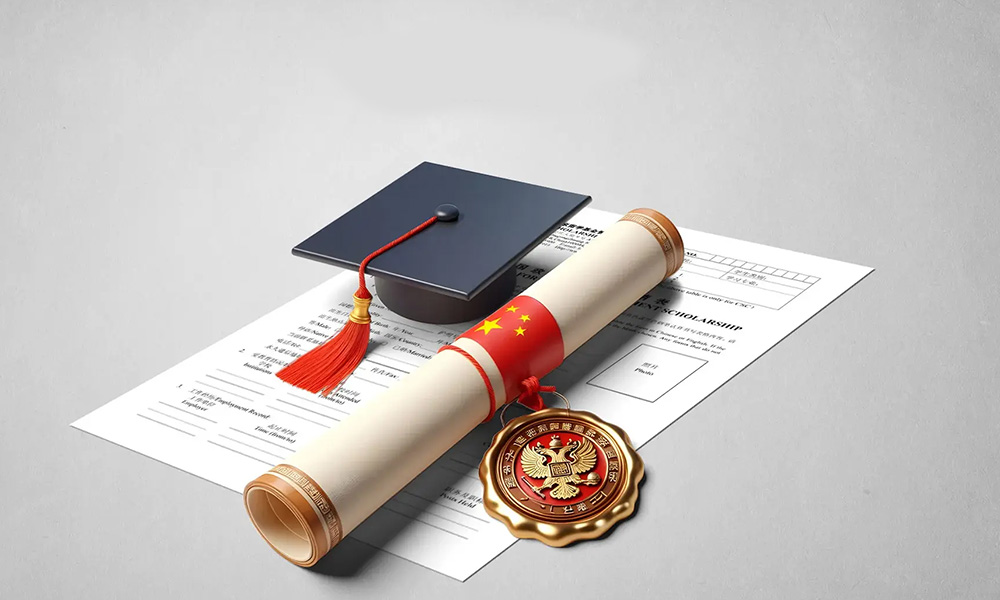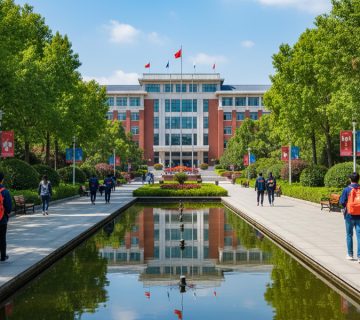With the world’s second-largest economy continuing to invest heavily in education and international cooperation, China has become a leading destination for foreign students seeking affordable but quality learning. In 2025, with over 500,000 foreign students studying in the country, scholarships in China are not merely financial aid; they are doorways to cultural assimilation, cutting-edge research, and lifelong networks. What draws the international scholars to types of Chinese scholarships for foreign students is how open and inclusive they are.
From cosmopolitan metropolises to serene coastal villages, these scholarships benefit undergraduates, graduates, and scholars from disciplines as diverse as Confucian classics and machine learning. The commitment of China’s government, guided by institutions like the China Scholarship Council (CSC), is an innovative strategy: international cooperation and mutual understanding. This article delves into the scholarship environment in China, decoding Chinese scholarships for foreign students, identifying universities with scholarships in China, and touching on essential practicalities like registration and documents. After reading this, you’ll have a guide to help ambition meet admission.
Top 5 Types of scholarships in China in 2025
Navigating scholarships in China scene is somewhat akin to navigating an archipelago huge in size—diverse, connected, and worth the effort if one sails carefully.

1. Chinese government Scholarships
At the heart of scholarships in China are the Chinese Government Scholarship (CGS) administered by the CSC, the flagship program. Launched to further education diplomacy, it awards over 40,000 international students annually to 289 accredited universities. The CGS is offered in three main flavors: Type A (bilateral agreements through dispatching authorities in your home nation), Type B (direct university nominations), and Type C (for particular initiatives such as the Belt and Road). All three types pay full tuition, accommodation, a monthly living allowance (up to CNY 3,500 for Ph.D. students), and whole medical insurance, which is a lifeline for Bachelor’s, Master’s, or Ph.D. students.
2. Belt and Road Initiative
Outside the CGS, the Belt and Road Initiative (BRI) Scholarship is a driving force for collaboration countries’ students—over 140 countries to date in 2025. Targeted towards infrastructure-based fields like civil engineering and sustainable development, it accordances top-of-the-line treatment to candidates from Asia, Africa, and Europe and equal full compensation, together with favored access into language preparatory programs. We have encountered winners from Kenya who attribute their turning point in their career in renewable energy projects back home to this scholarship.
3. Confucius Institute Scholarship
For language enthusiasts, the Confucius Institute Scholarship stands out, focusing on learning Chinese language and culture. Managed by Hanban (Confucius Institute Headquarters), it allows short-term immersion (3-12 months) in host schools worldwide, but in China, it is for degree courses for teaching Chinese to speakers of other languages (MTCSOL). It comes with exemption of tuition fees and CNY 2,500 monthly allowances, giving top priority to HSK skills. It’s particularly appealing for instructors; one of the Indonesian instructors we know used it to move from high school classrooms to university lectures.
4. Scholarships in China: Municipal and Provincial Awards
Municipal and provincial awards are another types of scholarships in China that bring local character, often filling the gaps that national programs cannot reach. Take the Jiangsu Jasmine Scholarship for humanities and sciences excellence, with partial to full funding for study at Nanjing’s historic universities. Shanghai Government Scholarships are for urban entrepreneurs, covering up to 100% for master’s in finance or technology. These are competitive but less bureaucratic, with deadlines loosely aligned with CGS cycles.

5. University Specific Scholarships
Scholarships specific to universities fill out the list, highlighting institution-strength. The Xiamen University Tan Kah Kee Scholarship, for instance, honors the philanthropist with scholarship-backed maritime study and economics, with research stipends included. Non-degree exchange, like the China Link Short-term Scientific Exchange under CSC, offers 1–12-month positions for undergraduate students and teachers, ideal for fine-tuning CVs without long-term commitment.
In weaving these strands together, you can observe that types of Chinese scholarships for foreing students are designed with flexibility in mind.
If you’re a prospective engineer wanting to flock to the labs of Tsinghua or a prospective doctor wanting to flock to Fudan’s, there’s a fit. The equation? Align your profile with the philosophy of the program—scholarship, cultural adaptability, and genuine interest in Sino-global ties. As 2025 opportunities become available, note well: these are not handouts; they’re investments in futures ahead.
| Scholarship Type | Tuition | Monthly Stipend | Degree Level | Target Region |
| CGS Type A | Full | CNY 3,000–3,500 | BSc, MSc, PhD | Global |
| BRI | Full | CNY 3,000 | MSc, PhD | BRI countries |
| Confucius | Partial | CNY 2,500 | Language/MTCSOL | Global |
China Universities Offering Scholarships
China’s tertiary scene is a rich tapestry of high-tech ambition and ancient heritage, with over 270 universities with scholarships in China for foreign students in 2025. They are not factories for producing diplomas; they are centers of innovation ranked on a global scale, from QS Top 50 to centers of excellence in specialized disciplines. Picking the best one means matching your goals with their strengths—whether Peking University’s interdisciplinarity or Harbin Institute of Technology’s engineering excellence.
1. Tsinghua University
Start with the “C9 League,” China’s Ivy League counterpart: Beijing’s Tsinghua University leads the pack, popularly known as the “MIT of the East.” Its scholarship offers, including full-ride CSC Type B and Siemens China Scholarship for PhD in AI and automation, draw over 4,000 internationals annually. Tsinghua’s Weiyang campus hums with collaborative energy; success stories of alumni like a Pakistani engineer who landed a Huawei job after graduation speak volumes about its hands-on laboratories.
2. Peking University
Another type of scholarships in China belongs to Peking University. Peking University, nearby, supplements the strands of medicine and public policy, and with the Yenching Scholarship—a CNY 30,000 stipend plus fees—for global affairs masters. Its scholarships emphasize leadership; envision diplomatic seminars beneath the willows of Weiming Lake.

3. Scholarships in China: Fudan University
Traveling south, Fudan University of Shanghai shines for medical and business degrees. The Fudan International Scholarship covers MBBS in its entirety, luring medical professionals of the future from the Middle East. The skyline of Shanghai provides a scenic backdrop for clinical rotations, winners benefitting from exposure to the largest Asian healthcare systems in the world.
4. Jiao Tong University
Neighboring Shanghai Jiao Tong University (SJTU) emphasizes engineers with its Med-X Research Institute, marrying medicine and technology—scholarships here enable interdisciplinary PhDs, leading to medical robotics innovations.
5. Xiamen University
For nautical environment, Xiamen University beckons with its Tan Kah Kee and XMU New International Student Scholarships, providing Belt and Road students with priority in marine sciences. Glancing over the Taiwan Strait, it’s a peaceful setting for focused learning; a Malaysian marine biologist we met described sorting through coral samples as she and fellow students from 50 nations debated sustainability.
6. Zhejiang University
In the city of technology, Zhejiang University (ZJU) in Hangzhou boasts the ZJU-UCL Institute scholarships that blend Chinese intensity with British flair for international business and engineering. Its 2025 cohort doubles up on English-taught programs, with allowances of up to CNY 3,000. Xi’an Jiao tong-Liverpool University (XJTLU) in Suzhou, a Sino-British university, has Belt and Road scholarships for architecture and data science—all the way for those wanting a Western-style curriculum in an Eastern setting.
7. Sichuan University
Don’t overlook mid-range jewels like Sichuan University in Chengdu, where campuses are panda-populated and subsidized by CSC for Chinese traditional medicine courses, or Wuhan University with its blossoming cherry-blossom walkways and scholarships for hydrology engineering. Northeastern powerhouses like Northeastern University in Shenyang fund materials science, riding China’s industrial revival.
These Chinese universities with scholarships for foreign students share internationalization—mandatory Chinese culture courses, orientation buddy systems, and alumni networks on continents. By 2025, expect enhanced virtual tours and AI-facilitated matching interfaces to simplify choice.

Scholarship in China 2025 Registration Time
Timing is everything for catching the scholarships in China, and for the intakes of 2025, the gate opens wide as those of the Forbidden City—splendid, yet with a firm shut. The CSC’s crown jewel scholarship has applications open from December 15, 2024, to April 30, 2025, although keen applicants notice that early birds (January-February) catch better opportunities. Type A (embassy route) varies country by country—check your local Chinese mission; for instance, the U.S. Embassy takes February deadlines, while African nations take as far as March.
University Scholarships
University plans (Type B) similarly but with institutional embellishments. Tsinghua portal is lit up in December, with applications by February 15 for September intakes. Fudan med scholarships come earlier to January 31, indicating high demand for clinical spots. Provincial ones like Jiangsu’s Jasmine are open in November 2024 and close mid-March 2025, often requiring pre-approval by host unis.
The process works in stages: online CSC registration (studyinchina.csc.edu.cn), then university websites—consider ZJU’s two- week verification system. After sending, wait 3-6 months for the reviews; results arrive June-July for fall admission. Setbacks? Visa processing takes another 1-2 months, so plan for summer language preparation if necessary.
Procrastination is the thief in my exchanges with past applicants. A Nigerian engineer lagged Tsinghua by a week last cycle; another, Brazilian, won early on the BRI quota. Trivias like CSC’s app trackers are handy to monitor status. In 2025, with all electronic refurbishments, expect smoother flows—but mark calendars reverently. This is no sprint; it is a marathon where beginnings count.
Scholarships in China in Engineering and Medical Fields Benefits
For those born with blueprints and scalpels, scholarships in China unlock doors where theory meets practical impact—think building high-speed rails or designing telemedicine for rural health clinics. In engineering fields, CSC and BRI scholarships shine brightest, paying for tuition (typically CNY 30,000+ per year) and providing CNY 3,000-3,500 stipends, which will get by on modest living in Beijing’s hutongs or Shanghai’s cafes. At HIT or Tsinghua, this translates to access to quantum computing facilities and wind tunnel labs comparable to those at NASA—hands-on training that pads resume with patents.
Medical specialties reap the same benefits. Scholarships from Fudan or Sichuan University’s CSC pay for MBBS tuition (CNY 50,000/year) and protection against the unexpected, like a flu during dissections. Stipends fund stethoscopes and textbooks, and partnerships with WHO familiarize students with international health protocols. A Tanzanian doctor we know used her scholarship to lead Ebola response units, crediting China’s emphasis on practical rotations.
More benefits? Dorms on campus for free allow serendipitous collaborations—late-night arguments at midnight around CAD files or case studies. Language classes fill in, becoming gliding ward rounds. Post-grad, 80% of winners report becoming more hireable; engineering graduates get hired at BYD or Siemens, med school graduates at foreign hospitals. Environmentally, the scholarships coincide with green initiatives—think solar engineering at ZJU.
Critics gripe about concessions to culture, but ROI is certain: debt-free expertise in high-demand fields, and a network across Belt and Road initiatives. In 2025, as China’s carbon-neutral effort kicks in, those advantages are amplified—funding sustainable engineering or AI-driven diagnostics. It’s not just education; it’s empowerment, that allows scholars to engineer and heal a connected world.

Required Documents for a Scholarship in China
Gathering your application file is akin to building a portfolio—each component needs to convey your narrative concisely, no filler. For CSC and relatives, begin with the online application: passport photo (white background, 480×640 pixels), biographical information, and study proposal (800-1,000 words, explaining why China, your area of study, and future contributions—plagiarism detection signals reject applications).
Core uploads: Certified diplomas/transcripts (in order of highest qualification, English/Chinese translation), two letters of recommendation (from employer/professors, sealed, on letterhead), and physical exam form (Foreigner Physical Examination Record—do it in six months at a legalized clinic; includes blood work and X-rays). Copy of valid passport (expiry date after March 2026), HSK/TOEFL scores for language streams, and police clearance (no-charge certificate from home authorities).
Extras are optional: PhD research proposal (5-10 pages, methodology-oriented), publications if available, or prof acceptance letter (increases Type B opportunities). Include portfolios or GRE scores for med/engineering. Print and scan all in color, PDF, under 5MB each.
Pitfalls? Incomplete sets lead to auto-rejects; one Vietnamese candidate lost her position due to a missing seal last year. DHL for hard copies to unis—track very carefully. In 2025, e-signatures get more streamlined, but authenticity rules. Master this, and your docs are your champion.
Conclusion
As sunset falls behind the Great Wall or rises above the Bund, scholarships in China inform us that education has no borders—it’s shared work braiding the future together. From the eclectic Chinese scholarships for international students to the vibrant universities with Chinese scholarships, these Chinese scholarships level playing grounds to achieve greatness. We have analyzed time lines, engineering-medical advantages, and doc requirements; action is now required. Use it boldly, take the leap—China waits not just as a classroom, but as a catalyst of change. Your chapter starts here. Seize this chance—apply thoughtfully, and let China’s vibrant campuses launch your journey toward impactful, debt-free excellence. For additional information, keep in touch.
FAQs About Scholarships in China for 2025:
1. What are the main types of Chinese scholarships available for international students in 2025?
The primary scholarships include the Chinese Government Scholarship (CGS) with Type A, B, and C categories, the Belt and Road Initiative Scholarship for infrastructure-related fields, and the Confucius Institute Scholarship for Chinese language studies. Additionally, provincial scholarships like Jiangsu Jasmine and university-specific awards, such as Xiamen University’s Tan Kah Kee, offer diverse funding options covering tuition, accommodation, and stipends.
2. When is the registration period for China scholarships in 2025?
The Chinese Government Scholarship application window opens December 15, 2024, and closes April 30, 2025, with earlier submissions (January-February) improving chances. University-specific deadlines, like Tsinghua’s (February 15) or Fudan’s (January 31), vary, while provincial scholarships often align with March closings. Check CSC and university portals for exact dates.
3. What documents are required to apply for a scholarship in China?
Essential documents include a completed CSC online form, notarized diplomas/transcripts, two recommendation letters, a physical exam form, a valid passport copy, HSK/TOEFL scores (if applicable), and a police clearance certificate. PhD applicants need a research proposal, and some programs may request portfolios or professor acceptance letters. All must be scanned in color, PDF format, and notarized where required.





No comment